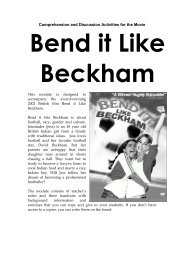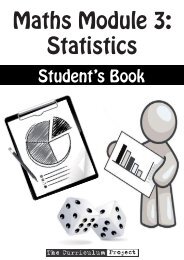General English Pre-Intermediate Modules 1-4 Teacher's Guide (2.1 ...
General English Pre-Intermediate Modules 1-4 Teacher's Guide (2.1 ...
General English Pre-Intermediate Modules 1-4 Teacher's Guide (2.1 ...
Create successful ePaper yourself
Turn your PDF publications into a flip-book with our unique Google optimized e-Paper software.
7. Writing: Filling in a Form<br />
This section looks at filling in forms, and the types of information people need to put in forms.<br />
7.1 Personal information<br />
A. Discuss forms. Ask students for experiences they have had filling in forms. Brainstorm a list of types<br />
of form people fill in, e.g.<br />
• application forms for study, scholarships, jobs, passports, visas, permits…<br />
• forms giving information, e.g when you post a parcel you need to say what is in it.<br />
B. Go through the list in the left column, and clarify any words and phrases students don’t understand.<br />
Students match the word/phrase in the first column (1-12) with the item in the second column (a-l).<br />
Answer key:<br />
1. c 2. f 3. i 4. j 5. h 6. b 7. k 8. l 9. e 10. a 11. g 12. d<br />
Language/Culture Notes<br />
In <strong>English</strong> the terms first name and given name have the same meaning. Also, last name, family<br />
name and surname all mean the same thing. For example, if the person’s name is John Hartford his<br />
first name (or given name) is John, and his last name (family name or surname) is Hartford. The family<br />
name is the name traditionally used to identify members of the family.<br />
However, many families have different names, as these days the wife often keeps her own name when<br />
she marries, and the children might have the mother’s family name, the father’s, or a combination of<br />
both (e.g. John Hartford and Joan Reed have a daughter called Stacy Hartford-Reed).<br />
As Burmese people usually don’t have first and family names, they need to decide how to write these<br />
on forms. Many people use the first part of their names as a first name, and the rest as a family name:<br />
San San Cho becomes first name: San San and family name: Cho. Others use an honorific as<br />
first name and their name as family name, e.g. first name: Daw and family name: San San Cho. In<br />
informal situations, foreigners unfamiliar with Burmese who see the name will probably call people by<br />
only what is written as the first name, e.g. San San or Daw, or formally Ms Cho or Ms San San Cho.<br />
C. Brainstorm a list of types of information people might have to put on forms, e.g.<br />
ID number, phone number, education, qualifications, work, religion, nationality…<br />
7.2 Complete the form<br />
A. <strong>Pre</strong>-teach signature.<br />
Students answer the questions with information about themselves.<br />
Check that they write their name in capital letters, and that the other information is correct.<br />
Possible answers:<br />
1. AUNG KYAW SOE<br />
2. AK Soe<br />
3. Circle the appropriate title. Mr / Ms / Mrs / Miss / Dr / Other<br />
4. a. Lashio b. Burma<br />
5. single / married / divorced / separated / widowed<br />
6. Burmese, Shan, <strong>English</strong>, Chinese<br />
B. Elicit the purpose of this form. Why would someone fill in this form<br />
Answer:<br />
It is for people applying to join a sports club. The sports club wants this information from<br />
their members.<br />
C. Students complete the form, using information about themselves.<br />
Module 1<br />
13


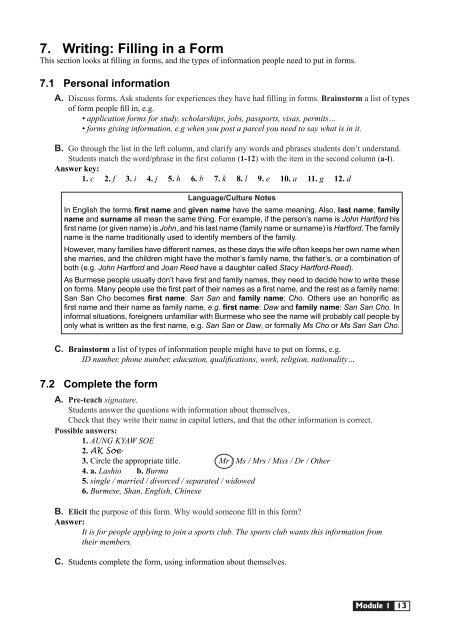
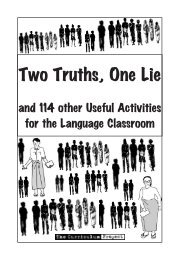
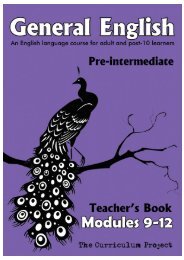




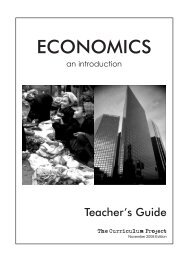
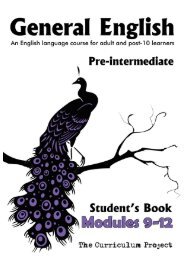



![[Eng] Nov 2012 DRAFT - The Curriculum Project](https://img.yumpu.com/45590859/1/184x260/eng-nov-2012-draft-the-curriculum-project.jpg?quality=85)
